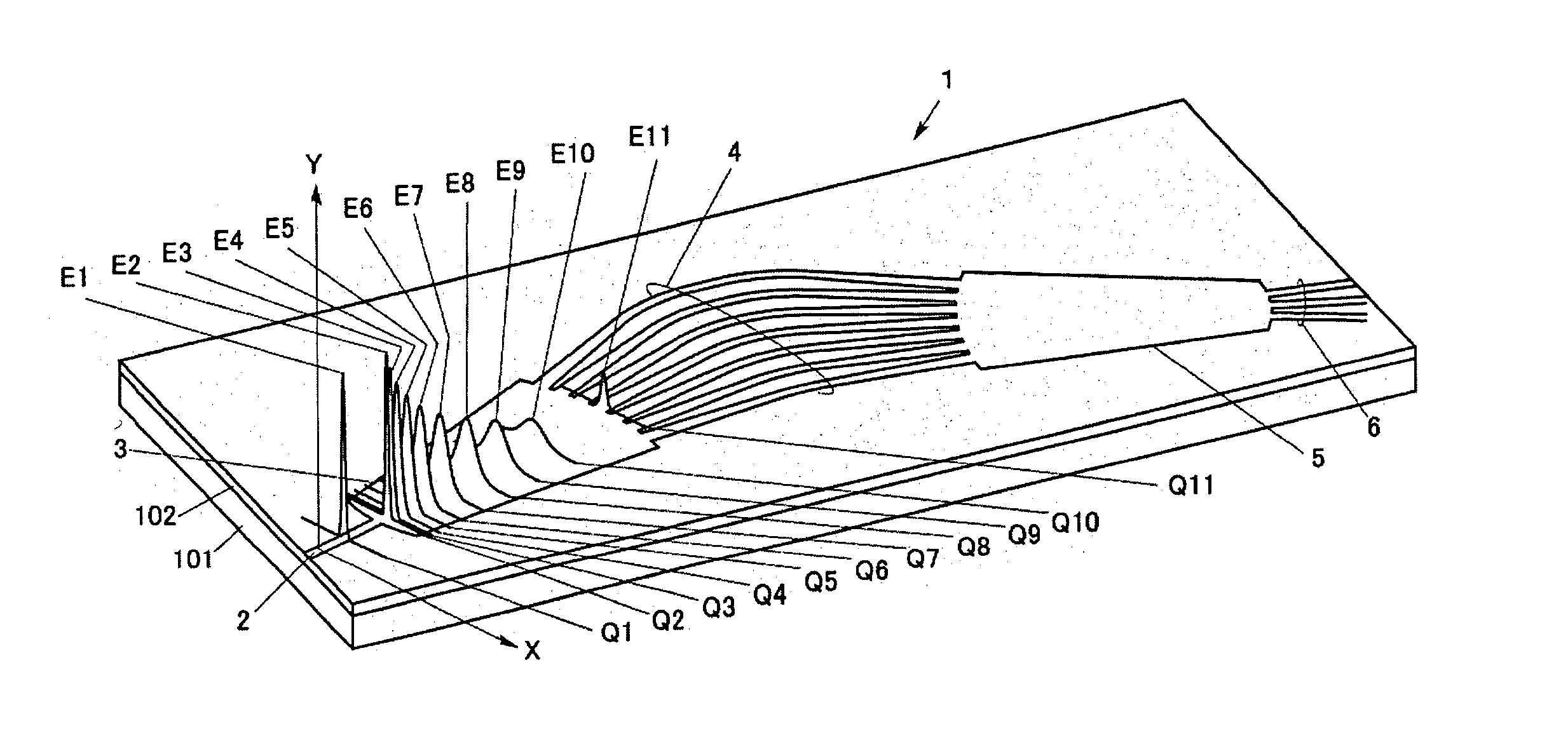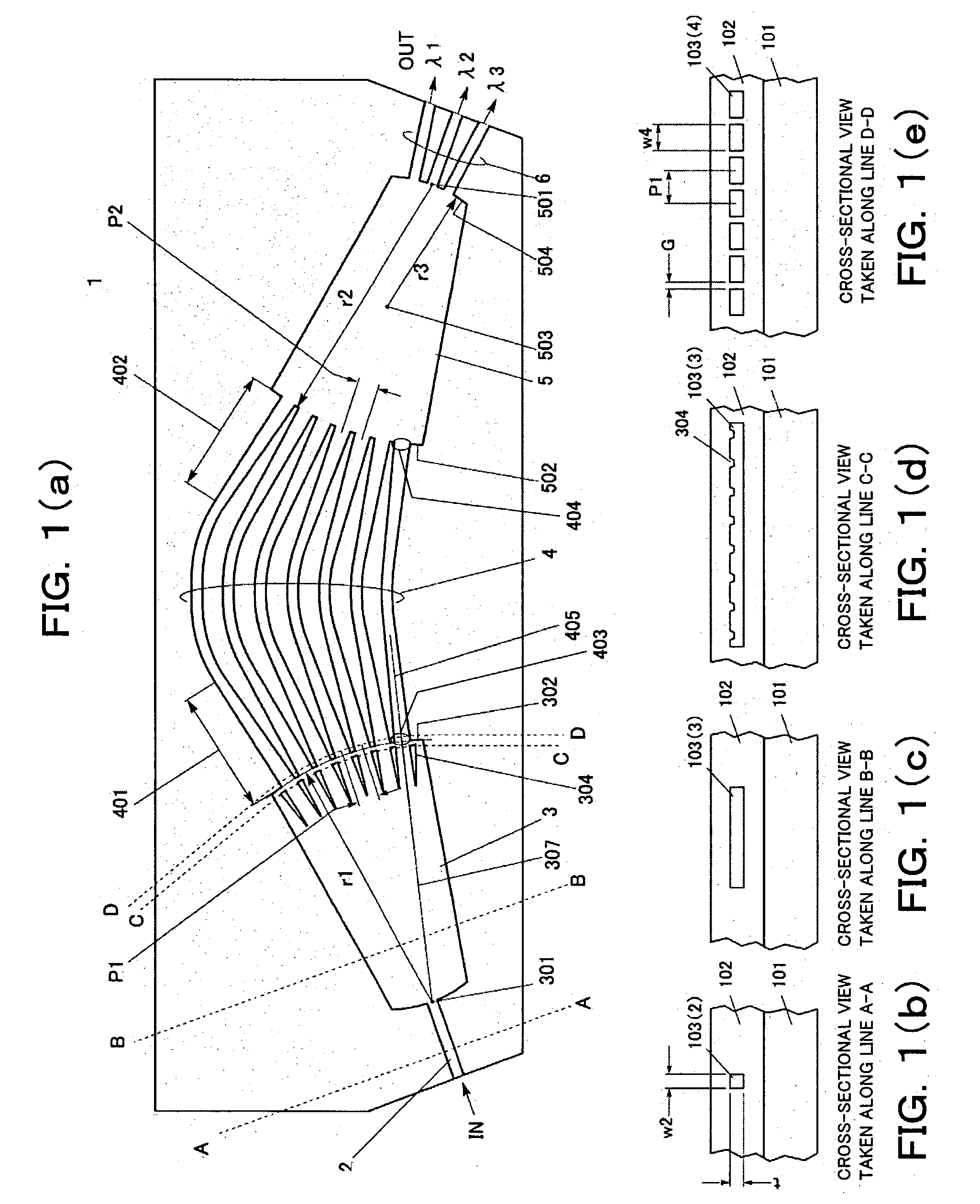Arrayed waveguide grating type wavelength division demultiplexer
a technology of array waveguide grating and wavelength division, which is applied in the direction of optical waveguide light guide, instruments, optics, etc., can solve the problems of inability to apply the above fabrication method, the device is manufactured, and it is difficult to completely fill the cladding material into
- Summary
- Abstract
- Description
- Claims
- Application Information
AI Technical Summary
Problems solved by technology
Method used
Image
Examples
first embodiment
[0115] FIGS. 5(a) to 5(c) are diagrams for explaining the (electric field) intensity profile of a bundle of light beams propagating from the input slab 3 to the phase-grating waveguide array 4 of the arrayed waveguide grating type wavelength division multiplexer / demultiplexer as the present invention. Unlike the arrangement shown in FIG. 3, the input slab 3 shown in FIGS. 5(a) to 5(c) is made to have the array of high refractive index regions in the above-described manner. Since the input slab 3 shown in FIGS. 5(a) to 5(c) has the array of high refractive index regions, the input slab 3 operates as follows. That is, when the light beams dispersed along the locus 80 from the light dispersion center 301 as a start point reach the wedge-shaped concave portions 304 or the vicinity thereof, the light beams are focused on the region (high refractive index region) interposed between the neighboring concave portions 304. This is because the thin portions of the core 103 at which the concave...
third embodiment
[0153] (C) Description of Third Embodiment
[0154] (C1) Description of Arrangement and Operation
second embodiment
[0155] FIGS. 14(a) to 14(e) are diagrams for explaining the present invention. Similarly to FIGS. 1(a) to 1(e), FIGS. 8(a) to 8(e), FIGS. 12(a) to 12(e), and FIGS. 13(a) to 13(e), FIG. 14(a) is a plan view showing an AWG type wavelength division multiplexer / demultiplexer according to the third embodiment of the present invention, FIG. 14(b) a cross-sectional view taken along a line A-A in FIG. 14(a), FIG. 14(c) a cross-sectional view taken along a line B-B in FIG. 14(a), FIG. 14(d) a cross-sectional view taken along a line C-C in FIG. 14(a), and FIG. 14(e) a cross-sectional view taken along a line D-D in FIG. 14(a).
[0156] Reference numerals are also introduced into FIGS. 14(a) to 14(e) in a similar manner so that they indicate the components corresponding to those in FIGS. 1(a) to 1(e), 8(a) to 8(e), 12(a) to 12(e) and 13(a) to 13(e). That is, reference numeral 1 represents the AWG type wavelength division multiplexer / demultiplexer, 2 the input waveguide, 3 the input slab, 4 the pha...
PUM
 Login to View More
Login to View More Abstract
Description
Claims
Application Information
 Login to View More
Login to View More - Generate Ideas
- Intellectual Property
- Life Sciences
- Materials
- Tech Scout
- Unparalleled Data Quality
- Higher Quality Content
- 60% Fewer Hallucinations
Browse by: Latest US Patents, China's latest patents, Technical Efficacy Thesaurus, Application Domain, Technology Topic, Popular Technical Reports.
© 2025 PatSnap. All rights reserved.Legal|Privacy policy|Modern Slavery Act Transparency Statement|Sitemap|About US| Contact US: help@patsnap.com



